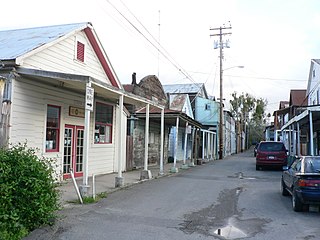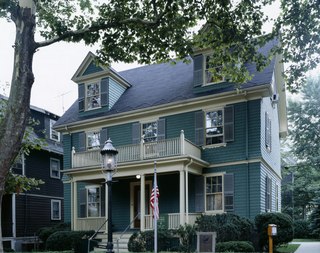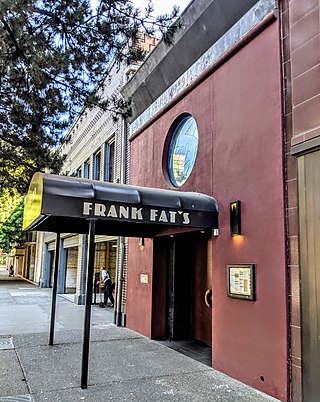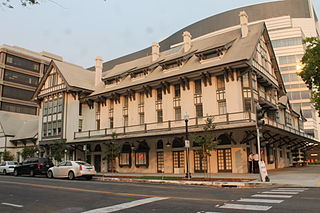
Sacramento is the capital city of the U.S. state of California and the county seat of Sacramento County. Located at the confluence of the Sacramento and American Rivers in Northern California's Sacramento Valley, Sacramento's 2020 population of 524,943 makes it the fourth-most populous city in Northern California, sixth-most populous city in the state, and the ninth-most populous state capital in the United States. Sacramento is the seat of the California Legislature and the Governor of California.

Locke, also known as Locke Historic District, is an unincorporated community in the Sacramento–San Joaquin River Delta of California, United States. The 14-acre town (5.7 ha) was first developed between 1893 and 1915 approximately one mile north of the town of Walnut Grove in Sacramento County.

The California State Capitol is the seat of the California state government, located in Sacramento, the state capital of California. The building houses the chambers of the California State Legislature, made up of the Assembly and the Senate, along with the office of the governor of California. The Neoclassical structure, designed by Reuben S. Clark, was completed between 1861 and 1874. Located at the west end of Capitol Park and the east end of the Capitol Mall, the building was added to the National Register of Historic Places in 1973. The California State Capitol Museum is housed on the grounds of the capitol.

The Fair Oaks Bridge is a truss bridge over the lower banks of the American River, connecting Fair Oaks to the greater Sacramento, California region. The current bridge, built 1907-1909 at a cost of $63,000, is the third bridge at this location.

Colonel Allensworth State Historic Park is a state park unit of California, United States, preserving Allensworth, the only California town to be founded, financed and governed by African Americans. The small farming community was founded in 1908 by Lt. Colonel Allen Allensworth, Professor William Payne, William Peck, a minister; John W. Palmer, a miner; and Harry A. Mitchell, a real estate agent, dedicated to improving the economic and social status of African Americans. Colonel Allensworth (1842–1914) had a friendship with Booker T. Washington and was inspired by the Tuskegee Institute and development in its neighboring town. Allensworth hoped to develop the "Tuskegee of the West".

The John Fitzgerald Kennedy National Historic Site is the birthplace and childhood home of John F. Kennedy, the 35th president of the United States. The house is at 83 Beals Street in the Coolidge Corner neighborhood of Brookline, Massachusetts. Kennedy is one of four U.S. presidents born in Norfolk County, Massachusetts. The property is now owned by the National Park Service; tours of the house are offered, and a film is presented.

The Ellwood House was built as a private home by barbed wire entrepreneur Isaac Ellwood in 1879. It is located on First Street in DeKalb, Illinois, United States, in DeKalb County. The Victorian style home, designed by George O. Garnsey, underwent remodeling in 1898-1899 and 1911. The house was originally part of 1,000 acres (4.0 km2) which included a large stable complex known as "Ellwood Green." Isaac Ellwood lived here until 1910 when he passed the estate to his son, Perry Ellwood.

Oak Park is a neighborhood in Sacramento, California. The McGeorge School of Law, University of the Pacific Sacramento Campus, Sacramento High School, and Christian Brothers High School are located in this neighborhood.

Delta King is a 285-foot-long sternwheel steamboat (87 m) and the sister ship of Delta Queen, built in Scotland and California for the California Transportation Company's service between Sacramento and San Francisco, California. She entered service in 1927 and continued until 1940. After wartime service with the United States Navy, Delta King served as an accommodation ship at Kitimat, British Columbia in the 1950s and then returned to California for static use at Old Sacramento where she remains as a hotel, restaurant and venue.

The California Governor's Mansion is the official residence of the governor of California, located in Sacramento, the capital of California. Built in 1877, the estate was purchased by the Californian government in 1903 and has served as the executive residence for 14 governors. The mansion was occupied by governors between 1903–1967 and 2015–2019. Since 1967, the mansion has been managed by California State Parks as the Governor's Mansion State Historic Park.
Boulevard Park is a historic residential neighborhood in Sacramento, California. It is also the Boulevard Park Historic District, listed on the National Register of Historic Places.

The Rockingham Hotel is a historic former hotel and contemporary condominium at 401 State Street in Portsmouth, New Hampshire, United States. Built in 1885, it is a prominent early example of Colonial Revival architecture, built in part in homage to Woodbury Langdon, whose 1785 home occupied the site. Langdon's home and the hotel both played host to leading figures of their day, and the hotel was one of the finest in northern New England. The hotel, now converted to condominiums, was added to the National Register of Historic Places in 1982.

The George W. Marston House, or George Marston House and Gardens, also referred to as the George and Anna Marston House or the Marston House, is a museum and historic landmark located in San Diego and maintained by Save Our Heritage Organisation (SOHO).

The Fraser Mansion is a building at 1701 20th Street NW, at the intersection of Connecticut Avenue, 20th Street, and R Street in the Dupont Circle neighborhood of Washington, D.C. constructed in 1890 to be the George S. Fraser mansion, it served as his private residence for five years, a restaurant, a boarding house, the home of the new Founding Church of Scientology, and—currently—the location of Scientology's National Affairs office.

Frank Fat's is an American Chinese cuisine restaurant in Sacramento, California founded in 1939 by a Chinese immigrant who called himself "Frank Fat" and who came to the United States illegally in 1919. The original restaurant is one of four now owned by the Fat family.

The Senator Hotel (1924–1979) was a nine-story, 400-room Italian Renaissance-style hotel in Sacramento, California located at 12th and L streets across from the California State Capitol building that served as a nexus of California political and social activity for more than 50 years. Opened in 1924, the Senator Hotel was where Arthur Samish, one of the most influential and powerful individual lobbyists in the history of California, maintained a suite during the 1930s and 1940s. President Gerald Ford spent the night at the Senator Hotel before the September 5, 1975, assassination attempt on him by cultist Manson family disciple Squeaky Fromme. Although the Senator Hotel was listed on the National Register of Historic Places in May 1979, the hotel was closed two months later and shuttered with panels placed over the windows that same year. The structure was renovated and then reopened in 1983 as an office building under the name Senator Hotel Office Building, giving lobbyists short-walking-distance access to California's state politicians.

The Old Tavern is a historic building listed on the National Register of Historic Places located in Sacramento, California.

The Heilbron House is a historic mansion in Downtown Sacramento, California. Built in 1881, it was initially the home of August Heilbron, a cattle rancher, merchant, and landowner who came from Germany.

The Cranston–Geary House also known locally as the Bramson Home is a historic home listed on the National Register of Historic Places. The house is a Craftsman-style home designed by George Sellon, California's first state architect.

The Log Cabin is a historic restaurant in Oak Park Heights, Minnesota, United States. It was established in 1932 as a roadhouse—an eatery and nightclub catering to motorists in an isolated location. Opening in the last years of Prohibition, it was rumored to serve illegal alcohol and harbor gangsters. The Log Cabin was listed on the National Register of Historic Places in 2007 for having local significance in the themes of architecture and commerce. It was nominated for its associations with the roadhouse network that developed in the early-20th-century St. Croix Valley, and for its quaint log cabin motif designed to attract the first generation of automobile travelers. Over the years it has operated under the names Club Tara Hideaway, Club Tara, and—since 1997—Phil's Tara Hideaway.























